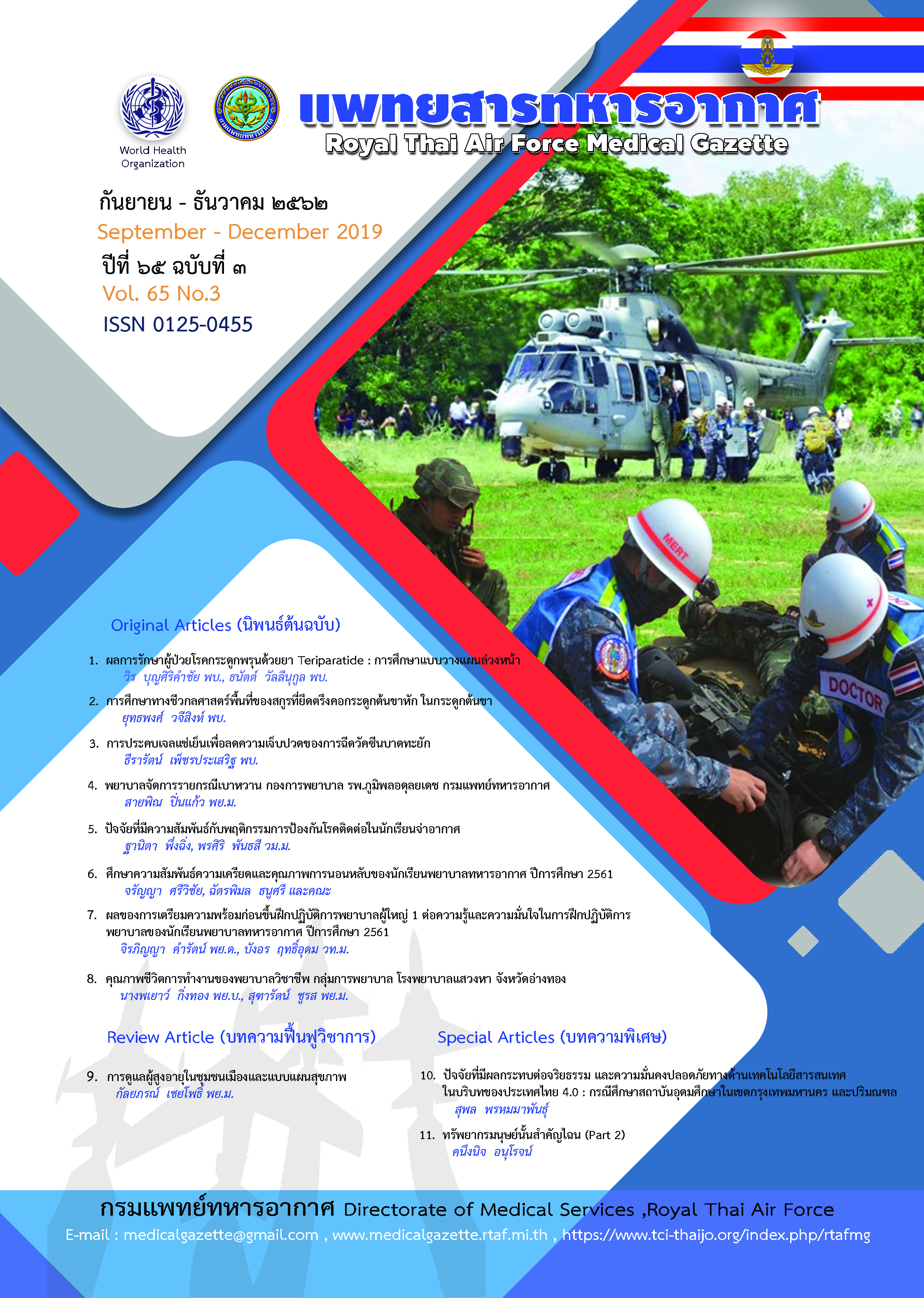Factors Related to Prevention Behavior for Communicable Disease in The Air Technical Students
Main Article Content
Abstract
Objective : This descriptive research aims to study the prevention behavior for communicable disease and relating factors including knowledge, perceived susceptibility, perceived benefits, preceived barriers and perceived self-efficacy.
Material and Methods : Cluster random participants were 164 air technical students. Data were collected by questionnaires. Statistical analysis used descriptive statistics, Pearson’s product moment correlations coefficient and stepwise multiple regression.
Results : The results revealed that knowledge, perceived susceptibility, perceived benefits and perceived self-efficacy were in good level but the perceived barriers were in moderate. Knowledge, perceived susceptibility, perceived benefits and perceived self0efficacy had significant positive relationship with prevention behavior for communicable disease. (r = .196, .314, .400 and .349, p < .01) but perceived barriers had significant negative relationship with prevention behavior for communicable disease. (r = -.286, p < .01). Furthermore, perceived benefits, perceived barriers and perceived self-efficacy were able to predict prevention behavior for communicable disease 30.4 % (R2 = 0.304, p < .001)
Article Details

This work is licensed under a Creative Commons Attribution-NonCommercial-NoDerivatives 4.0 International License.
บทความที่ได้รับการตีพิมพฺเป็นลิขสิทธิ์ของวารสาร
References
antimicrobial resistance in Thailand 2017-2021 (Online), 2017 August 14.
2. พงษ์พิสุทธิ์ จงอุดมสุข. เชื้อดื้อยาปฏิชีวนะ วิกฤติและทางออกของสังคมไทย. สถาบันวิจัยระบบสาธารณสุข. 2555;1(1).
3. พรรณรวี โพธิ์เทียนทอง. Antimicrobial Resistance A Global Concern. วารสารเพื่อการวิจัยและพัฒนาองค์การเภสัชกรรม.
2559;23(3):9-12.
4. สำนักงานโรคติดต่อทั่วไป กรมควบคุมโรค กระทรวงสาธารณสุข, สถานการณ์โรคไข้หวัดใหญ่ (Online), 2018 May 26.
5. สำนักงานโรคติดต่อทั่วไป กรมควบคุมโรค กระทรวงสาธารณสุข, แผนงานวิจัย ควบคุมโรคและภัยสุขภาพ พ.ศ. 2562-2564 (Online),
2019 Jan 27.
DATA0000/00000275.PDF>.
6. WHO, Global TB Report (Online), 2017 May 18.
7. Becker MH. The health belief model and sick role behavior. In MH Becker (Ed.), The health belief model and
personal health behavior. Thorofare, NJ: Charles B. Slack 1974:82-92.
8. อนญัญา คูอาริยะกุล, ฉลองรัตน์ มีศรี. ความรู้และพฤติกรรมการดูแลตนเองของผู้ป่วยโรคความดันโลหิตสูง โรงพยาบาลส่งเสริม
สุขภาพตำบลป่าเช่า อำเภอเมือง จังหวัด อุตรดิตถ์. วารสารวิทยาลัยพยาบาลบรมราชชนนี อุตรดิตถ์, 2560;9(2):28-40.
9. นันท์นภัส เพ็ชรสุวรรณ, สุเวช พิมน้าเย็น, ผลการใช้โปรแกรมการส่งเสริมการปฏิบัติสุขอนามัยส่วนบุคคลต่อความรู้ ทัศนคติ
พฤติกรรมการป้องกันโรคอุจจาระร่วงในชุมชนชาวไทย ภูเขาเผ่าม้ง อำเภองาว จังหวัดลำปาง. สมาคมสถาบันอุดม ศึกษาเอกชนแห่ง
ประเทศไทยในพระราชูปถัมภ์ สมเด็จพระเทพรัตนราชสุดาฯ สยามบรมราชกุมารี, 2560;6(1):15-26.
10. นงนุช เสือพูมี. ความสัมพันธ์ระหว่างปัจจัยส่วนบุคคลความรู้กับพฤติกรรมการป้องกันวัณโรคปอดของประชาชน ตำบลสวนกล้วย
อำเภอบ้านโป่ง จังหวัดราชบุรี. วารสาร พยาบาลกระทรวงสาธารณสุข. 2556:79-93.
11. ศุภโชค ตรรกนันท์, วัลลภ แดงใหญ่, ภาวฤณ ลีฬหวนิช และศุภขจี แสงเรืองอ่อน. การศึกษาพฤติกรรมเสี่ยง ต่อการติดเชื้อเอชไอวี
ของพลทหารกองประจำการในเขตกรุงเทพมหานคร. เวชสารแพทย์ทหารบก. 2559;69(2):55-63.
12. Pender NJ. Health promotion in nursing practice. USA: Appleton and Lange. 2006.
13. สมใจ จางวาง, เทพกร พิทยภินัน, นิรชร ชูติพัฒนะ. ปัจจัยที่มีความสัมพันธ์กับพฤติกรรมการดูแลตนเองเพื่อป้องกันโรคเบาหวาน
และความดันโลหิตสูงของประชาชนกลุ่มเสี่ยง. วารสารเครือข่ายวิทยาลัยพยาบาลและการสาธารณสุข ภาคใต้. 2559;3(1):110-28.
14. Bandura A. Self-efficacy: The exercise of control. New York: W. H. Freeman. 1997.
15. อรวรรณ จุลวงษ์. แรงจูงใจในการป้องกันโรคกับพฤติกรรมสุขภาพของพลทหารกองประจำการ. วารสารพยาบาลทหารบก
2557;15(2):28-32.
16. Salazar MK. Comparison of four behavioral theories a literature review. Am Assoc Occup Health Nurs.
1991;39:128-35.
17. สุจิตรา เหมวิเชียร, ประณีต ส่งวัฒนา, วิภาวี คงอินทร์. ปัจจัยที่มีอิทธิพลต่อพฤติกรรมการป้องกันโรคหัวใจและหลอดเลือด ของ
สตรีไทยมุสลิมวัยหมดประจำเดือน. สงขลานครินทร์เวชสาร. 2550;25(5):379-88.
18. อมรรัตน์ ภิรมย์ชม, อนงค์ หาญสกุล. ปัจจัยที่มีอิทธิพลต่อพฤติกรรมการดูแลตนเองของผู้ป่วยเบาหวานชนิดที่ 2 ในอำเภอหนองบัว
ระเหว จ.ชัยภูมิ. วารสารสำนักงานควบคุมโรค ที่ 6 ขอนแก่น. 2555;19(1).

